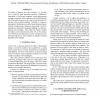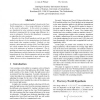105
Voted
IMAGING
2003
15 years 2 months ago
2003
Color is of interest to those working in computer vision largely because it is assumed to be helpful for recognition. This assumption has driven much work in color based image ind...
114
click to vote
ICIAP
2009
ACM
15 years 5 months ago
2009
ACM
This paper presents a framework for using high-level visual information to enhance the performance of automatic color constancy algorithms. The approach is based on recognizing spe...
75
Voted
HAIS
2010
Springer
15 years 5 months ago
2010
Springer
Abstract. Color constancy and chromatic edge detection are fundamental problems in artificial vision. In this paper1 we present a way to provide a visualization of color constancy...
122
click to vote
ROBOCUP
2004
Springer
15 years 6 months ago
2004
Springer
Abstract. To date, RoboCup games have all been played under constant, bright lighting conditions. However, in order to meet the overall goal of RoboCup, robots will need to be able...
ICMCS
2005
IEEE
15 years 6 months ago
2005
IEEE
The ability of humans for color constancy, i.e. the ability to correct for color deviation caused by a different illumination, is far beyond computer vision performances: nowadays...
86
Voted
ACCV
2007
Springer
15 years 7 months ago
2007
Springer
This paper introduces a novel convex kernel based method for color constancy computation with explicit illuminant parameter estimation. A simple linear render model is adopted and ...
ICIP
2005
IEEE
16 years 2 months ago
2005
IEEE
A well-known color constancy method is based on the GreyWorld assumption i.e. the average reflectance of surfaces in the world is achromatic. In this article we propose a new hypo...
110
Voted
ICIP
2007
IEEE
16 years 2 months ago
2007
IEEE
115
Voted
CVPR
2007
IEEE
16 years 2 months ago
2007
IEEE
Conventional stereo matching algorithms assume color constancy on the corresponding opaque pixels in the stereo images. However, when the foreground objects with fractional bounda...
100
click to vote
ICCV
2009
IEEE
16 years 5 months ago
2009
IEEE
The aim of color constancy is to remove the effect of the
color of the light source. As color constancy is inherently
an ill-posed problem, most of the existing color constancy
...






